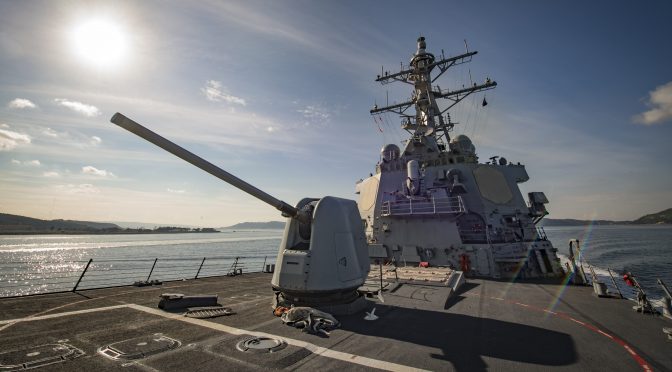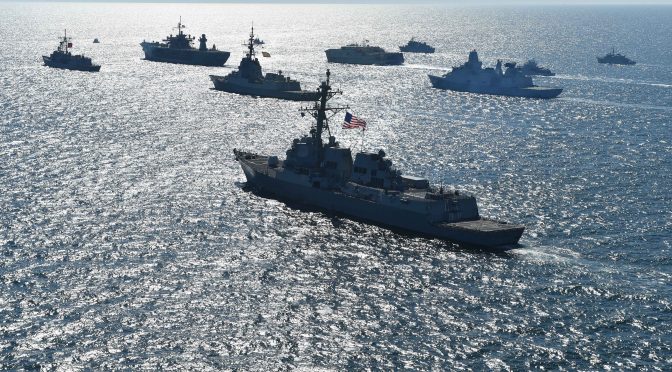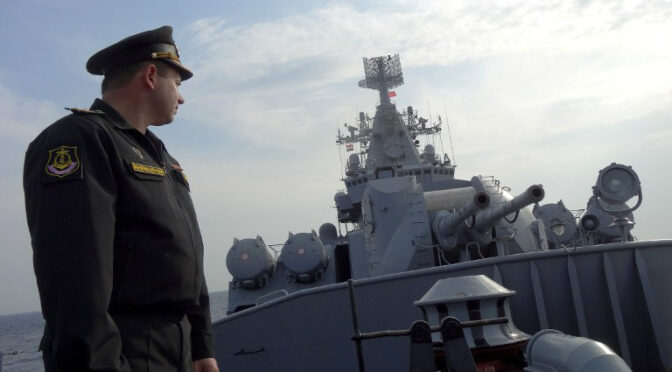By Colin Barnard
In a recent article for CIMSEC, I proposed three ways to improve U.S. maritime posture in Europe, including the forward basing of small surface combatants in the Baltic and Barents Seas. Due to the Montreux Convention, however, only littoral states are able to base warships in the Black Sea, which excludes the United States and all but three NATO members: Romania, Bulgaria, and Turkey. Recognizing this limitation and others on overall NATO maritime posture in the region, Russia has invested heavily in expanding and modernizing its Black Sea Fleet to maintain a position of relative strength and ensure its unfettered access to sea lanes, which it has used in recent years to continue its destabilization of Ukraine and Georgia and resupply its forces in Syria and Libya (the latter in violation of UN sanction regimes).
In order to protect its members and their interests against the possibility of further Russian aggression in the region, as well as to safeguard maritime security in the Black Sea, NATO needs to enhance its maritime presence and improve its balance of forces with Russia. To this end, NATO must find a solution to address the current limitations of its Black Sea maritime posture, in particular the Montreux Convention, but also the low capacity of Black Sea NATO navies and the lack of sufficient NATO maritime command and control in the region. This article explains the extent of these limitations and proposes a solution: expanding NATO’s maritime security operation, Operation Sea Guardian, to the Black Sea.
Limitations on NATO Black Sea Maritime Posture
The most significant limitation on NATO’s Black Sea maritime posture is the Montreux Convention. Some of the many stipulations of the convention are positive for NATO, e.g. giving Turkey control of the Bosporus and Dardanelles Straits. However, the agreement forbids non-littoral navies from forward basing warships in the Black Sea and restricts them to sailing there for a period of no more than 21 days. After the 21 days have passed, non-littoral navies must transit back through the Straits to the Aegean Sea in order to reset the clock. These restrictions are problems for NATO because only three of its members—Romania, Bulgaria, and Turkey—are allowed to operate navies in the Black Sea on a permanent basis. This is one of the reasons why neither the United States nor NATO had adequate presence and situational awareness at the start of the Russo-Georgia War in 2008 and the illegal annexation of Crimea in 2014, both of which involved significant Russian naval operations in the Black Sea.
The United States and NATO have since improved their ability to respond to a crisis in the region through NATO Assurance Measures, which include more frequent patrols by U.S. warships and NATO’s Standing Naval Forces (SNF) in the Black Sea, the latter of which is the maritime arm of NATO’s Very High Readiness Joint Task Force (established in 2014 after Russia’s annexation of Crimea). Unfortunately, the reality is that neither of these crises lasted long enough for such a response to matter.
More frequent patrols by U.S. and NATO warships in the Black Sea within Montreux’s 21-day limit are critical for conventional deterrence and reassurance to NATO allies and partners, but they are not enough on their own to achieve an adequate NATO maritime posture. Posture implies readiness to respond to the full range of threats, military and non-military, that Russia poses to the region. Effectively identifying and disrupting Russia’s use of criminal networks to destabilize NATO allies and partners alike, for example, requires permanent, sustained presence and situational awareness.
A second limitation on NATO’s Black Sea maritime presence is the low capacity of Black Sea NATO navies. The largest and most capable of the three is the Turkish Navy, which includes submarine forces, but even it cannot provide the presence and situational awareness across the Black Sea that NATO requires. This is due, at least in part, to the fact that Turkish naval forces must split their attention between the Black, Aegean, and Mediterranean Seas, where Turkey has numerous interests. Romania and Bulgaria, in contrast, operate only a small number of frigates, corvettes, and mine countermeasures ships between them. Romania has announced plans for four new multirole frigates, which will be useful once delivered, but Bulgaria appears only to be purchasing two, less capable offshore patrol two vessels.
While these naval forces are a critical part of NATO’s order of battle (and indeed they routinely support NATO maritime activities), they lack the capacity to deter Russia’s Black Sea Fleet and enforce maritime security in the region when not supplemented by other NATO forces. Furthermore, as Russia has increased its air, submarine, and amphibious forces in the Black Sea, large multirole combatants, such as Romania’s two Type 22 frigates, are required in far greater numbers than Black Sea navies can currently field, especially when maintenance and training cycles are factored in.
In addition to large combatants, more capable small combatants are required to bolster overall presence and perform maritime security tasks such as interdiction operations, which Romania’s new frigates and perhaps Bulgaria’s new patrol vessels, depending on their capability, will help address. Close NATO partners Ukraine and Georgia have the potential to add to the number provided by NATO navies, especially after the U.S. transfer of Island-class cutters to both states, and the planned transfer of Mk VI patrol boats to Ukraine. These platforms will expand Ukraine’s and Georgia’s range of patrolling their own maritime borders with Russia (for Ukraine, this includes inside the Sea of Azov), which benefits NATO as well.
Finally, NATO lacks sufficient maritime command and control (C2) in the Black Sea to conduct operations. Currently, NATO maintains what is called “Tailored Forward Presence” in the region. This presence is centered around a multinational division headquarters in Bucharest, which commands land forces also based in Romania, as well as two NATO Force Integration Units (NFIU), one in Romania and one in Bulgaria. None of these headquarters are maritime. The NFIUs, tasked with integrating NATO forces in the event of crisis and conflict, rely on the SNF to be the maritime arm of the VTJF under control of NATO’s Allied Maritime Command (MARCOM) in the United Kingdom. In peacetime and the outset of a crisis, NATO relies entirely on MARCOM to conduct maritime operations in the Black Sea. When the SNF is not in the Black Sea, however, MARCOM is not guaranteed to have control of naval forces in the region. This creates a lag, if not a gap entirely, in NATO’s situational awareness and ability to respond to maritime security incidents and crises in the Black Sea.
Outside observers may argue unwittingly that warships operating under national authority of a NATO member can suffice for overall NATO presence and thus deterrence, but the NATO command structure is distinct from national command structures, with its own C2, classification categories, and so on. The public may not be able to see a difference between a U.S. maritime patrol in the Black Sea and a patrol by a NATO standing maritime group, but the difference matters. This is one reason I argued for NATO navies above the Arctic Circle to form a standing maritime group to provide steady presence and maritime security in the European Arctic. As in the Barents Sea, NATO via MARCOM requires a standing maritime group of some sort in the Black Sea, providing direct input to its operational picture (not via its national command first) and able to react immediately to security incidents and crises at or from the sea.
Solutions to Improve NATO’s Black Sea Maritime Posture
Recommendations to mitigate th
Currently, OSG’s AO only includes the Mediterranean Sea, but justification for expanding it is easy to find. OSG’s primary line of effort is maritime situational awareness, which entails a broad range of information and intelligence gathering activities, supported by submarines, surface ships, and aircraft. These activities naturally interact with both military and commercial vessels of interest, which do not always stay in the Mediterranean. The Black Sea in particular hosts a number of smuggling operations, most of which have been consolidated and expanded through Russia’s occupation of Ukraine and Georgia. These operations include the overt and covert transport of arms and fuel to Russian-associated forces in Syria and Libya. In the case of Syria, Ben Hodges, a former commander of Allied Land Command and current Pershing Chair at the Center for European Policy Analysis, tweeted that Germany, France, Turkey, and the United States should work together to prevent Russia’s use of its bases and ports in the Black Sea to support the Assad regime.
Recognition of Russia’s use of ports and sea lanes in the Black Sea to support its forces and proxies not only in the Black Sea, but elsewhere, is important, but preventing it remains a challenge. One way could be to sanction and interdict non-Russian-flagged vessels supporting Russian resupply efforts. In truth, these vessels are already violating EU sanctions on Syria, yet the EU has done nothing to enforce them. OSG would be the ideal operation to support an embargo of non-Russian-flagged shipping supporting Russian resupply efforts. This would likely result in Russia reflagging much of this shipping, as Iran has done to prevent interdiction of its own shipping in European waters; but this would be a good result. Russia should be required to flag all shipping supporting its military and proxy engagements. This would make it easier for the UN, NATO, and the rest of the world to understand where and how Russia engages in the world, which could result in stronger international support against Russia when it undermines international law and norms.
If NATO pursues such an embargo operation, it would serve a more important recognition that maritime security and sanctions enforcement are important in competition with Russia. In his article with CIMSEC critiquing NATO’s 2011 Alliance Maritime Strategy, Ian Sundstrom advocated for a NATO maritime operation focused on Russian deterrence, which OSG currently is not. In fact, at present, NATO’s SNF are not the primary forces deployed in support of OSG, though they often augment OSG task groups, which usually means patrolling part of the area designated for an OSG focused operation (FOCOP). The forces which make up OSG task groups are instead volunteered from NATO navies on a rotational basis. MARCOM, which commands OSG, has operational control of these forces for specific periods of time. The reason the SNF are not the primary forces deployed for OSG is because of the prevailing notion in NATO that the task of maritime security is wholly separate from deterrence against Russia.
This notion has been challenged time and again by crises in NATO’s backyard, yet it remains. For example, OSG has conducted FOCOPs in the Eastern and Central Mediterranean on numerous occasions during the ongoing civil wars in Syria and Libya, and the task of detecting vessels smuggling arms, fuel, or people in violation of international law has directly overlapped with the task of tracking Russian military activity. The concept of a competition continuum, recently adopted by the U.S. sea services in their latest maritime strategy, recognizes the role of low-end maritime security tasks in military competition. Competing daily against Russia and other malign actors requires not only conventional deterrence demonstrated through the deployment of high-end forces, but also constabulary presence to detect and disrupt “gray zone” activities. Rotational forces supporting OSG centered around the navies of Black Sea NATO members would be able to work together to this end, a framework that can and should be duplicated throughout the rest of Europe.
An ancillary benefit of expanding OSG’s AO to include the Black Sea would be reassurance to Ukraine and Georgia. Since Russia’s annexation of Crimea in 2014 and, more recently, its de facto embargo of Ukrainian ports in the Sea of Azov highlighted by its temporary closure of the Kerch Strait in 2018, the United States and other NATO members have been supporting Ukraine and Georgia in their respective pursuance of NATO membership and deterrence posture against Russia. An OSG task group operating in the Black Sea would be able to sustain presence near the maritime boundaries Ukraine and Georgia share with Russia through exercising, information sharing, and patrolling with Ukrainian and Georgian naval and coast guard forces. Importantly, Georgia has maintained a liaison officer in MARCOM for years, whose role includes support to OSG. Both Georgia and Ukraine were active members of OAE, and the relationships that existed before Russia’s invasions of both countries could be quickly repaired under the umbrella of OSG.
Caveats and Conclusion
An important caveat to the expansion of OSG to the Black Sea is the need for all NATO members to support it, especially Turkey, which is the prime mover for NATO in the region. OSG has already suffered a black eye in the Mediterranean because of disagreements between NATO members, specifically Turkey and France, over the course of the Libyan civil war. The disagreements culminated last year in an unsafe interaction off the coast of Libya involving the French frigate Courbet, flagship for an OSG task group, and three Turkish frigates operating under Turkish national control (though also, ironically, in associated support to OSG). When Courbet intercepted the Tanzanian-flagged (at the time) vehicle carrier, CIRKIN, identified as potentially carrying military cargo from Istanbul to Libya in violation of UN sanctions, a Turkish frigate used its fire control radar to track the French frigate, or so the French claim. The fallout of this interaction was France’s withdrawal from supporting OSG.
This interaction should not have surprised anyone. NATO knew its members were increasingly at odds over the clash of interests in Libya, and that Turkey was actively shipping military equipment to its forces and proxies in Western Libya; yet NATO still allowed for an OSG patrol to take place off the coast of Libya. NATO usually suffers paralysis when its members do not agree, though in this case, it was not so much paralysis as it was a failure to address the elephant in the room. Whether one agrees with France or Turkey on its approach to Libyan civil war, the problem for OSG is that it is a maritime security operation, which implies it recognizes and upholds international law, including UN sanctions. Successful expansion of OSG to the Black Seaㅡi.e., providing NATO with rotational forces to enforce maritime security and erode Russia’s ability to destabilize the regionㅡwill require NATO consensus. If NATO cannot find consensus, then the advantage goes to Russia and other malign actors.
NATO needs to enhance its maritime presence in the Black Sea and improve its balance of forces with Russia, despite the current limitations of the Montreux Convention, the low capacity of Black Sea NATO navies, and the lack of sufficient NATO maritime command and control in the region. These limitations can be mitigated by expanding OSG’s AO to include the Black Sea. An OSG task group supported by the rotation of non-littoral NATO navies, operating alongside Black Sea NATO and partner navies, would improve NATO’s maritime posture in the region to deter Russia and safeguard maritime security—two tasks which are often inseparable.
Colin Barnard is a U.S. Navy foreign area officer currently in training for an exchange with the German Navy. He was formerly a staff operations and plans officer at NATO Maritime Command in the U.K. In addition to writing for the U.S. Naval Institute’s Proceedings and the Center for International Maritime Security, he is a PhD student at King’s College London with a focus on European maritime security. The views expressed in this publication are the author’s and do not imply endorsement by the U.S. Defense Department or U.S. Navy.
Featured Image: DARDANELLES STRAIT (Jan. 19, 2019) The Arleigh Burke-class guided-missile destroyer USS Donald Cook (DDG 75) transits the Dardanelles Strait, en route to the Black Sea, Jan. 19, 2019. (U.S. Navy photo by Mass Communication Specialist 2nd Class Ford Williams/Released)





